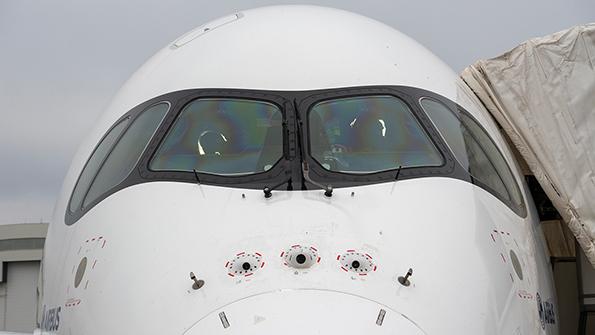Airbus Adds Autonomous Emergency Diversion Capability In Flight Tests

Cameras for the vision-based automatic landing system are mounted on the nose of the A350-1000 test aircraft.
Automated emergency diversion after pilot incapacitation in cruise, with the aircraft making a vision-based automatic landing at an alternate airport, is among the autonomous capabilities Airbus is demonstrating using an A350-1000 test aircraft.
The European manufacturer is expanding its research into autonomous flight systems to enhance safety and operational efficiency with ground and flight tests of pilot-assistance technologies under the Dragonfly program.
- System autonomously selects emergency
- It also recognizes the runway and lands the aircraft
Supported by French government funding, Dragonfly is a follow-on to the two-year Autonomous Taxi, Takeoff and Landing (ATTOL) project completed by Airbus’ UpNext flight demonstrators unit in June 2020.
ATTOL demonstrated fully autonomous, vision-based taxiing, takeoff and landing using onboard image recognition. Also using an A350-1000 test aircraft, the project concluded with six test flights at Toulouse-Blagnac Airport.
“The next step after the ATTOL proof of concept is to demonstrate a solution we can apply to a global environment, wherever Airbus aircraft can land, in any environmental conditions,” says Arne Stoschek, head of the Wayfinder autonomous flight project at Airbus’ Silicon Valley innovation unit Acubed.
Under Dragonfly, a series of flight-test campaigns has begun that are scheduled to continue into April. The focus of the project is technology maturation, after which Airbus will decide how to package the capability. “The next step is to look at certifiability,” Stoschek says.
For Dragonfly, the A350 has been equipped with cameras and a computing infrastructure for image processing and automated communication with air traffic control and the airline operational control center, as well as ways for the onboard system to assist the pilot via audible and visual means.
The A350 is already equipped with an automated emergency descent function, which is triggered when cabin pressure falls below a preset limit. After alerting the crew, the system engages the autopilot to bring the aircraft to a safe lower altitude if there is no pilot reaction within 15 sec.
Dragonfly adds the capability to automatically select an emergency diversion airport—taking into account external factors such as flight zones, terrain and weather—and plan a trajectory to the alternate, where the camera system will be used to identify the runway and guide the aircraft to a landing.
The project also is exploring taxi-assistance features in tests at Toulouse-Blagnac. These provide the crew with audio alerts in reaction to obstacles as well as assisted speed control and guidance to the runway using a dedicated airport map.
An autonomous emergency recovery capability is already available in general aviation with Garmin’s certified Autoland system. The challenge for Airbus, Stoschek says, is to develop a solution that is scalable to global commercial operations—day, night and in different weather conditions.
Vision-based automatic landing is based on collecting data to train machine-learning models to recognize runways and other landmarks. “We have to develop algorithms to cope with operational diversity,” he says. “We are working to understand what level of data diversity and coverage we need.”
While the type and diversity of training data needed is an ongoing research topic, so is how the autonomous flight system will communicate with the pilot, Stoschek says. “What type of audio alert, what type of visual way do we use to present this information? What you want to do is reduce the pilot workload, and that means you have to do it in a way that it doesn’t add to the pilot workload.”
Whereas ATTOL was focused on daylight landings at one airport, Dragonfly is expanding this to a limited number of airports and environments. “Once we demonstrate a reasonable number of airports and set of weather conditions, that will give us an indication that it isn’t impossible globally,” Stoschek says.
“The goal is ultimately to scale to 2,000-plus airports that will be relevant for us to land on, where the conditions can be very variable,” he says. “And why are we doing that? We see that in the context of increased safety and creating an additional layer of redundancy to ensure that, in whatever conditions an aircraft operation could encounter, it has the means to continue in a safe way.”

Comments